Achilles Tendon Rupture & Inflammation
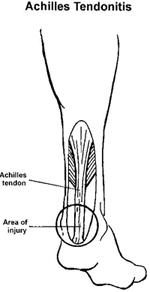 The
Achilles tendon is the thick cord felt behind the ankle which attaches
the powerful calf muscles to the back of the heel. It is the biggest
and strongest tendon in the body and made up of fibres called collagen.
The Achilles takes all the force during walking and running as the calf
muscles contract to pull the foot down. Therefore, if the tendon is
injured it is difficult to walk normally.
The
Achilles tendon is the thick cord felt behind the ankle which attaches
the powerful calf muscles to the back of the heel. It is the biggest
and strongest tendon in the body and made up of fibres called collagen.
The Achilles takes all the force during walking and running as the calf
muscles contract to pull the foot down. Therefore, if the tendon is
injured it is difficult to walk normally.
Achilles tendinosis
With age, the collagen fibres may become less flexible and weak. Injuries tend to occur in middle-aged athletes.
Small 'micro-tears" in the tendon may occur as part of an over-use injury. This may result in inflammation and a painful swelling as the body attempts to repair the tendon. An area just a few centimetres above the heel attachment is prone to injury due to a poor local blood supply - this is away from the insertion into the heel and called 'Non-insertional Achilles Tendinosis".
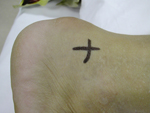 Some
people have a prominent bump of bone at the top of the heel which can
cause inflammation of the tendon and a pocket of fluid (called a
bursa). This combination may lead to a painful prominence directly on
the back of the heel and is called 'Insertional Achilles Tendinosis".
Some
people have a prominent bump of bone at the top of the heel which can
cause inflammation of the tendon and a pocket of fluid (called a
bursa). This combination may lead to a painful prominence directly on
the back of the heel and is called 'Insertional Achilles Tendinosis".
It is not often necessary to perform many investigations but your specialist may arrange for an ultra-sound scan or MRI scan
Treatment
The majority of patients with Achilles tendinosis do not require surgery. In fact, since the introduction of highly effective non-invasive treatments like Extracorporeal Shockwave Therapy, surgical intervention is extremely rare. As with any other type of overuse injury, rest from the precipitating cause along with specific stretching exercises usually help. Analgesics such as paracetamol and anti-inflammatory tablets from your doctor may help reduce the pain and inflammation. A 1cm heel lift may be placed in the shoes for a short time to help reduce the final strain on the tendon during walking.
A typical treatment programme would include:
- Physiotherapy with a specialist Physiotherapist
- Heel raising inserts to relieve tension on tendon
- A course of ECWT
A physiotherapist will be able to advise you on specific exercises and direct treatment accordingly.
(Click here for Achilles tendinosis exercises)
A few patients do not improve without an operation. If surgery is
required, then this is aimed at removing the inflamed tissue from the
tendon or its lining. In Insertional Achilles Tendinosis the bony bump
on the heel and the inflamed bursa may also be removed.
(Click here for operation information)
Acute Achilles tendon rupture
With a sudden rupture of the whole tendon it is usually obvious that a severe injury has occurred. Some people report hearing a 'crack" with a sharp pain behind the heel as if someone has hit them. There is normally immediate weakness of 'push-off" when walking.
Treatment
If you believe that you have suffered a complete rupture, you should seek urgent medical advice. The treatment may be immobilisation in a plaster cast or boot for several weeks. However, surgery to repair the tendon may be advised as this can lead to a more rapid recovery and return to sporting activities. Surgical repair also has a lower rate of re-rupture and is stronger.
The operation used to be performed through a long incision down the back of the Achilles but new technical advances have led to a horizontal "mini-incision" being possible. This leaves a small scar of just 2-3cm reducing the chances of wound healing problems and tethering of the skin that could happen with the more conventional operation.
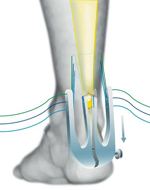
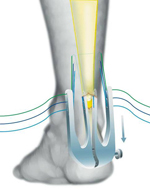
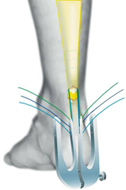
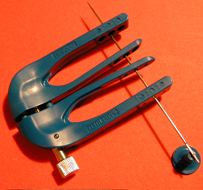
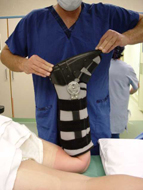
Pictures of the new Ahillon(TM) device
The key to recovery is a rapid rehabilitation program under physiotherapy supervision. Patients are fitted with a range of motion brace which allows early mobilisation.
The Fortius Clinic has been at the forefront of developing the mini-incision technique and has the expertise and facilities on hand to achieve early rehabilitation.